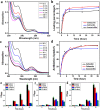Anion-Responsive Metallopolymer Hydrogels for Healthcare Applications
- PMID: 26202475
- PMCID: PMC4511866
- DOI: 10.1038/srep11914
Anion-Responsive Metallopolymer Hydrogels for Healthcare Applications
Abstract
Metallopolymers combine a processable, versatile organic polymeric skeleton with functional metals, providing multiple functions and methodologies in materials science. Taking advantage of cationic cobaltocenium as the key building block, organogels could be simply switched to hydrogels via a highly efficient ion exchange. With the unique ionic complexion ability, cobaltocenium moieties provide a robust soft substrate for recycling antibiotics from water. The essential polyelectrolyte nature offers the metallopolymer hydrogels to kill multidrug resistant bacteria. The multifunctional characteristics of these hydrogels highlight the potential for metallopolymers in the field of healthcare and environmental treatment.
Conflict of interest statement
The authors declare no competing financial interests.
Figures




Similar articles
-
Water-enhanced Removal of Ciprofloxacin from Water by Porous Graphene Hydrogel.Sci Rep. 2015 Sep 4;5:13578. doi: 10.1038/srep13578. Sci Rep. 2015. PMID: 26336922 Free PMC article.
-
Antifouling and antimicrobial cobaltocenium-containing metallopolymer double-network hydrogels.Biomater Transl. 2022 Jun 28;3(2):162-171. doi: 10.12336/biomatertransl.2022.02.008. eCollection 2022. Biomater Transl. 2022. PMID: 36105565 Free PMC article.
-
Confined Flocculation of Ionic Pollutants by Poly(L-dopa)-Based Polyelectrolyte Complexes in Hydrogel Beads for Three-Dimensional, Quantitative, Efficient Water Decontamination.Langmuir. 2015 Jun 16;31(23):6351-66. doi: 10.1021/acs.langmuir.5b01084. Epub 2015 Jun 1. Langmuir. 2015. PMID: 25981870
-
How to Construct DNA Hydrogels for Environmental Applications: Advanced Water Treatment and Environmental Analysis.Small. 2018 Apr;14(17):e1703305. doi: 10.1002/smll.201703305. Epub 2018 Feb 16. Small. 2018. PMID: 29450972 Review.
-
Fate of antibiotics during municipal water recycling treatment processes.Water Res. 2010 Aug;44(15):4295-323. doi: 10.1016/j.watres.2010.06.020. Epub 2010 Jun 15. Water Res. 2010. PMID: 20619433 Review.
Cited by
-
ROMP Synthesis of Iron-Containing Organometallic Polymers.Molecules. 2016 Feb 6;21(2):198. doi: 10.3390/molecules21020198. Molecules. 2016. PMID: 26861276 Free PMC article. Review.
-
Metal-containing and related polymers for biomedical applications.Chem Soc Rev. 2016 Oct 7;45(19):5232-63. doi: 10.1039/c6cs00026f. Epub 2016 Feb 24. Chem Soc Rev. 2016. PMID: 26910408 Free PMC article.
-
Hydrodynamic Characteristics and Conformational Parameters of Ferrocene-Terpyridine-Based Polymers.Polymers (Basel). 2022 Apr 27;14(9):1776. doi: 10.3390/polym14091776. Polymers (Basel). 2022. PMID: 35566943 Free PMC article.
-
Polymerization-Induced Self-Assembly of Metallo-Polyelectrolyte Block Copolymers.J Polym Sci (2020). 2020 Jan 1;58(1):77-83. doi: 10.1002/pola.29439. Epub 2019 Jul 10. J Polym Sci (2020). 2020. PMID: 34337427 Free PMC article.
-
Biodegradable polycaprolactone metallopolymer-antibiotic bioconjugates containing phenylboronic acid and cobaltocenium for antimicrobial application.Biomater Sci. 2021 Oct 26;9(21):7237-7246. doi: 10.1039/d1bm00970b. Biomater Sci. 2021. PMID: 34596174 Free PMC article.
References
-
- Haque M. A., Kurokawa T. & Gong J. P. Super tough double network hydrogels and their application as biomaterials. Polymer 53, 1805–1822 (2012).
-
- Li P. et al. A polycationic antimicrobial and biocompatible hydrogel with microbe membrane suctioning ability. Nat. Mater. 10, 149–156 (2011). - PubMed
-
- Wang Q. et al. High-water-content mouldable hydrogels by mixing clay and a dendritic molecular binder. Nature 463, 339–343 (2010). - PubMed
-
- Appel E. A., del Barrio J., Loh X. J. & Scherman O. A. Supramolecular polymeric hydrogels. Chem. Soc. Rev. 41, 6195–6214 (2012). - PubMed
Publication types
MeSH terms
Substances
LinkOut - more resources
Full Text Sources
Other Literature Sources
Medical
Molecular Biology Databases

